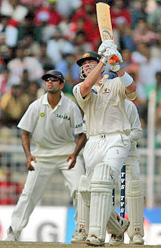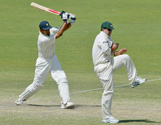COACHING
Footwork Works
- By Ashok Mankad
There is obviously no single key that can unravel
the many secrets of the art of batting. There are
several, of which 'Footwork' is one of the most
critical. It is to batting what the foundation is
to a building. Without it, there can be no
structure.

Damien Martyn displays his footwork
in the Chennai Test, October 2004.
A
batsman can get away a few times with fantastic
hand-eye coordination and minimal footwork, but not
for a very long time. Bowlers at the international
level will not take long to sort you out. Of
course, there are always exceptions, like our very
own VVS Laxman and Virender Sehwag. But then, they
are exceptions, and one must not forget that. The
'step-out-and-drive' stroke, which is usually
executed against a spinner, cannot be played
without effective footwork. Hand-eye coordination
without footwork will not help. Hand-eye
coordination may also not work in isolation on
wickets on which the ball is not coming on to the
bat. Footwork becomes vital when the batsmen have
to go for the ball rather than wait for it to come
to them.
Every batsman should strive to attain perfect
hand-eye-feet coordination. Perfection is of course
not possible to achieve, but one can try and come
close.
Many cricket pundits will define good footwork as
technically correct footwork. But is that enough?
The answer is 'no'.
For the batsman, good, impeccable technique should
go hand in hand with correct judgement of the speed
at which he should move his feet. For instance, if
he moves back in the perfect and technically
correct manner, but is slow in doing so, he may be
bowled or trapped LBW. On the other hand, he may
lob a simple catch in the air if he is too early
into his shot.

Rahul Dravid drives leg-spinner Stuart
MacGill on India's tour
of Australia in 2003-04.
Batsmen who are quick on their feet are at an
advantage, especially against slow bowling. A
batsman who jumps down the wicket to attack a
spinner and then decides against playing the shot
at the last moment or in some cases, misses the
ball, will be able to go back and regain his crease
if his footwork is good.
A visible characteristic of great players is the
apparent ease with which they play their strokes.
They always seem to be in the right position to
play their shots, with plenty of time to spare. Sir
Don Bradman, Sunil Gavaskar and Rahul Dravid are
some batting greats to come to mind when one thinks
about batsmen whose footwork helps them put
themselves in the best position to play their
strokes. In fact, achieving the right position
amounts to winning half the battle as far as
strokeplay is concerned.
Skipping can play as important a role in cricket as
it does in sports like boxing, hockey, tennis and
athletics. It improves cardio-vascular fitness,
which is a bonus for a sportsman. It helps in
keeping the feet light, which in turn, develops
one's footwork. My father, the legendary Vinoo
Mankad, used to tell us to skip in the
dressing-room at regular intervals whenever we were
awaiting our turn to bat, and a big partnership was
developing in the middle. He advocated skipping as
it kept the legs moving and blood flowing!
Nearly every outdoor sport requires a specific type
of footwork. In cricket for instance, one need not
skip continuously, whereas in boxing, a player
needs to have a lot of stamina and so will need to
skip for longer periods. The first thing I used to
put in my kitbag in my playing days was the
skipping rope. I used to skip in sets of 100/200/
500, and ensure that I did 1000 daily. Not only did
it improve my batting, but also my agility and
running between the wickets. Nirupama Mankad, my
wife, who did the country proud in tennis, used to
do 5000 skips daily!
It can be said categorically that footwork is the
essence of a successful sports career, without
which he / she will struggle in the long run.